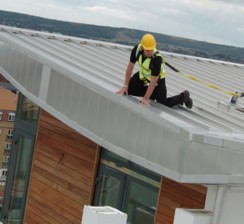Personal Fall Arrest Equipment

OSHA requires a Fall Protection program and training whenever you are 4 feet above the next level in General Industry, 5 feet in Maritime and 6 feet in Construction. Fall Arrest Safety programs are not only mandatory but they make the difference between life and death or life altering injuries.
Would you gamble with your life? Some people do just that; they fail to inspect their personal fall arrest equipment daily. They gamble that the equipment will save their life if they fall. Wearing fall arrest equipment without inspecting it provides a false sense of security.
Fall Arrest equipment is subject to tremendous loads during a fall. Unless each component is thoroughly inspected daily, it may not save your life. Always follow manufacturers’ recommendations when inspecting your equipment.
Here are several things to look for.
Belts & Body Harnesses:
Thoroughly inspect all nylon webbing on the body harnesses for frayed edges, broken fibers, burn marks, deterioration or other visible signs of damage. The stitching should be intact and not torn or loose. The harness should be somewhat “soft” and flexible and not stiff from dirt or contaminants.
Check to see that buckles and “D” rings are not distorted or damaged. Look closely at all components for stress cracks, deformity, gouging, corrosion and sharp edges. Inspect connection points where the buckle or “D” ring is attached to the belt or body harness. Insure that no stitching is pulled and that the buckle or “D” ring is securely attached.
Inspect all rivets and grommets to be certain they are not deformed, and are securely fastened to the body harness and cannot be pulled loose. If you find any of these conditions during the inspection, do not use the equipment.
Lanyards:
Completely check the entire length of the lanyard. Look for cuts, fraying, deterioration, knots, kinks, burns or visible signs of damage. Stitching should be intact and not torn or loose. Spliced ends must also be carefully examined for damage or deterioration. Check to see that the lanyard is somewhat “soft” and not stiff from dirt or contaminants.
If using a “shock absorber” type of lanyard, look for the “warning tag” which indicates that the lanyard has been exposed to a fall.
Snap hooks and eyes should not be distorted or bent. Inspect them for cracks, sharp edges, gouges or corrosion. Check to be sure the locking mechanism is operating properly and that there is no binding of the mechanism.
If using a self retracting lanyard (SRL), you must inspect the body of the mechanism for flaws to assure that all nuts, screws and rivets are installed and tight. Also check crimped ends or stitching for damage. Inspect the entire length of the SRL for any visible signs of defects.
Test the locking mechanism by pulling sharply on the cable end to be sure it locks immediately and firmly.
Don’t Gamble with your life, inspect your Fall Arrest equipment daily!